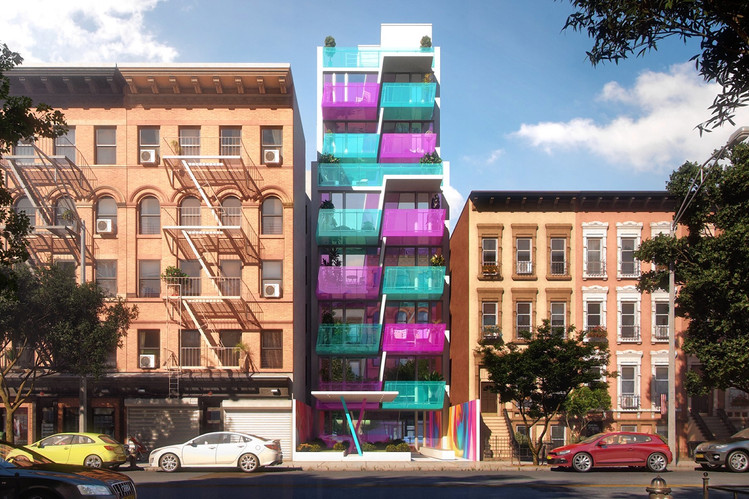
Neighbors Upset With Balcony Colors Get Vote From Developer
Neighbors along a block of century-old buildings on Pleasant Avenue in East Harlem weren’t pleased when a developer broke ground in April on a narrow concrete-and-glass building with eye-popping bright pink and turquoise balconies.
Now the developer, HAP Investments LLC, is offering the disgruntled neighbors and architectural aficionados everywhere an opportunity to collaborate: They can vote to choose a new color scheme for the project.
But even before the votes are counted, some neighbors still aren’t happy.
Eran Polack, chief executive of HAP, a development and investment group, promised to change the balcony colors of the 30-foot-wide building to the choice that gets the most votes in a poll conducted at the construction site and online.
“I think it was the color that was giving people the impression that it is out of context,” he said. “Maybe with a different color people will think it is part of the neighborhood.”
They say the design of the market-rate rental building is an intrusion on the block, mostly because the developer decided to set the front entrance 28 feet back from the sidewalk, thrusting the bulk of the structure back toward the backyards of 10 smaller buildings.
“They should pick it up and move it to Mars,” said Laurena Torres, a commercial real-estate broker who lives around the corner on East 118th Street. “There it would be contextual.”
The building was created by Karim Rashid, an Egyptian-born industrial designer based in New York, who says he has designed more than 3,000 products, from luxury goods to soap bottles to manhole covers. Many have bright colors, and pink is a favorite.
On Pleasant Avenue, angled walls on the balconies create an S-shape pattern going up the building front. A 6-foot-high digital ceramic mosaic mural will extend along a 28-foot wall in the entrance plaza.
Voters will be able to choose from a version of the current colors to some more soothing combinations such as white with magenta trim that gets lighter toward the top of the building.
The online survey will be available until Oct. 3. On-site voting at 329 Pleasant Ave. will take place on Oct. 2 from 4 to 7 p.m. and Oct. 3 from 8 to 11 a.m.
Preservationists say this modern building on a street of older homes raises questions about how much new design should respect or reflect the traditional values of a neighborhood.
Peg Breen, president of the New York Landmarks Conservancy, said the building “looks like it belongs in Miami Beach” rather than East Harlem.
“This building is totally out of context,” she said. “It doesn’t matter what the color is. It doesn’t show any respect for the neighborhood. I don’t think saying you are going to be cutting- edge gets you a free pass.”
But Mr. Rashid said he doesn’t believe architects have to “marry or reflect existing surroundings.”
“A building should evolve and push the neighborhood to change and speak of the time in which we live,” he said. “What makes cities beautiful is the collage of periods, growth and diversity.”
Still, Mr. Rashid said he believed his building has some neighborhood context that was set by building codes and zoning codes rules, with their many requirements for setbacks and lighting. He calls his building a form of “affordable luxury.”
The building is going up—foundation work began a few weeks ago—on a lot that is 143 feet deep, much deeper than the typical 100-feet-deep Manhattan lot.
The deep lot allowed HAP to move the building toward the rear, angering neighbors. Since the spring, they—along with local elected officials—have been trying to get the developers to line up the front of the building with other buildings on the street.
Mr. Polack said the front setback was required by zoning rules, but Assemblyman Robert J. Rodriguez, who represents the area, disputed that.
“We hate the color, we think it is ridiculous,” Mr. Rodriguez said. “But that is the most minor issue they could address. They have bigger issues.”
Mr. Rashid’s design for HAP 5, the 20-unit rental building on Pleasant Avenue, is one of four designs for buildings in East Harlem he has developed for HAP. Another has a seven-story wall of irregular triangles of glass panes fitted together.
Mr. Polack said he is working closely with the neighbors, who are worried about losing light and views of an empty lot that will soon provide much-needed housing in the city.
“That is the nature of cities,” he said.